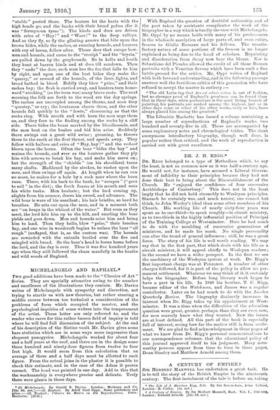MICHELANGELO AND RAPTI - ATM.*
Two good additions have been made to the " Classics of Art " Series. They are specially attractive owing to the number and excellence of the illustrations they contain. Mr. Davies writes of Michelangelo with sympathy and discretion, not trying to startle us with new theories, but rather steering a middle course between too technical a consideration of the problems of form which occupied the master, and the psychological inquiries of some writers into the temperament of the artist. These latter are only referred to, and the reader who cares for this rather barren field of inquiry is told where he will find full discussion of the subject. At the end of his description of the Sistine vault Mr. Davies gives some bare statistics which are in some ways more impressive than eloquent panegyrics. Michelangelo worked for about four and a half years at the roof, and there are in the design some three hundred and ninety-four figures from twelve to four feet high. It would seem from this calculation that an average of three and a half days must be allotted to each figure. From the actual joins in the plaster it is possible to check this estimate, and in the case of the Adam it proves correct. The head was painted in one day. Add to this that the workmanship is everywhere precise and delicate. Truly there were giants in those days.
• (1) Michelangelo. By Gerald S. Davies. London: Methuen and Co. [12s. 6d. net.]—(2) Raphael. By Adolf Paul Oppe. Same publishers and price.—(3) .Raphael Muer° du Maitre en 275 Reproductions. Paris: Hachette. [10 fr.]
With Raphael the question of doubtful authorship and of the part taken by assistants complicates the work of the biographer in a way which is hardly the case with Michelangelo. Mr. Oppe by no means holds with many of his predecessors in the wholesale ascription of large parts of, and even entire, frescos to Giulio Romano and his fellows. The unsatis- factory nature of some portions of the frescos is no longer explained as being due to the band of scholars. Repainting and discoloration from decay now bear the blame. Nor is Sebastiano del Piombo allowed the credit of all those Roman portraits with a Venetian flavour which have been such a fine battle-ground for the critics. Mr., Oppe writes of Raphael with both love and understanding, and in the following passage answers well the fastidious critics of this generation who have refused to accept the master in entirety
The old Latin tag that Ars est celare artem is out of fashion, but no stronger proof of Raphael's greatness ean be found than that in these days, when portraiture is the most living branch of painting, his portraits are ranked among the highest, just as in other days some or other of his other works, early or late, have always placed him among the greatest."
The Librairie Hachette has issued a volume containing a large number of reproductions of Raphael's works, two hundred and seventy-five in all. These are accompanied by some explanatory notes and chronological tables. The short anonymous introductory biography, though well done, is popular rather than critical, and the work of reproduction is carried out with great excellence.






































 Previous page
Previous page